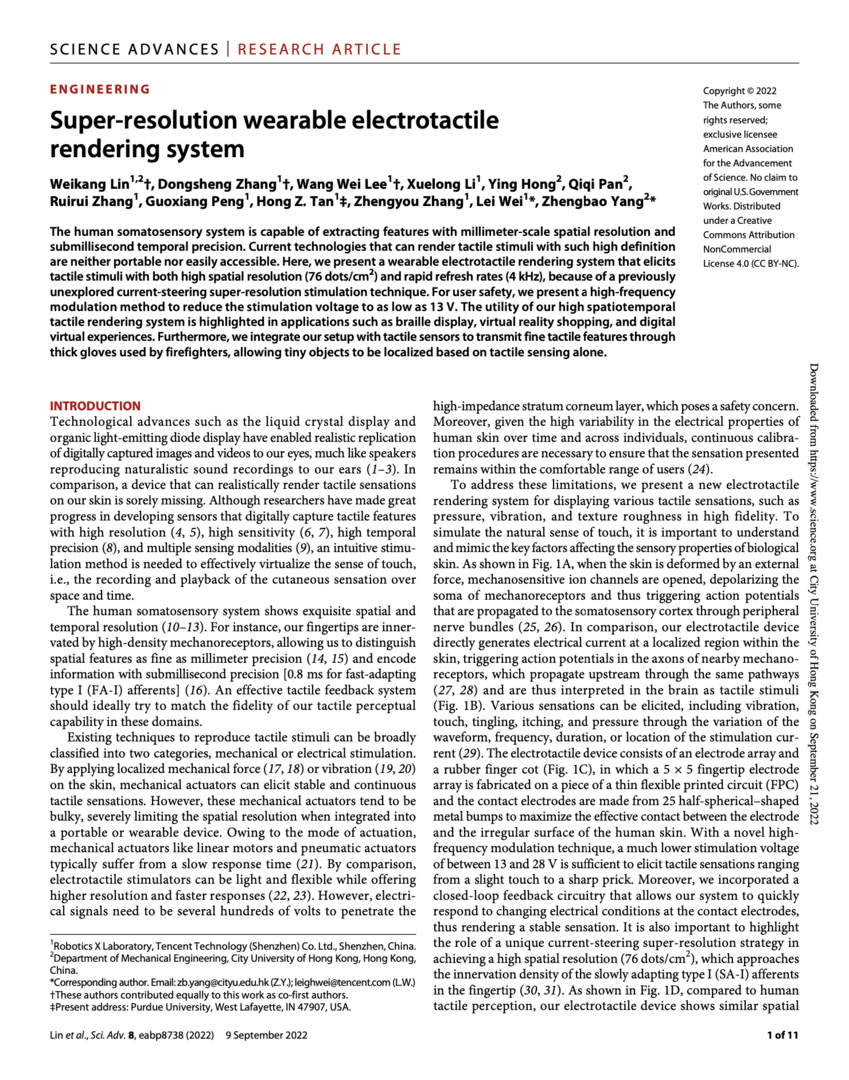
The missing puzzle |Touch
Touch is one of five essential human senses.
With displays and cameras, we're able to capture and reproduce sound and sight. Virtual Reality(VR) takes our experience of interacting with the digital world to the next level - with advanced optics enabling depth and perception for better immersion. However, to further improve a better sense of presents, we need a way to reproduce the sense of touch.
From a warm handshake or sympathetic hug to a congratulatory pat on the back. Humans have developed complex body language to aid communication, cultures, and emotional expressions through physical contact. This paper presents a breakthrough tactile rendering technology which fills the gap in advancing the sense of touch in the digital world.
Existing techniques to reproduce tactile stimuli can be classified into two categories - mechanical and electrical stimulation. By applying localized mechanical force or vibration on the skin, mechanical actuators can provide stable and continuous tactile sensations. However, mechanical actuators are bulky. And the spatial resolution of mechanical actuators is limited when integrated into a portable or wearable device.
While the second category of tactile stimuli technique; electrotactile stimulators, can be light and flexible while offering higher resolution and faster responses. They require high voltage to penetrate the outer layer of our skins to activate the nerves. This led to safety concerns, together with the problem of tingling sensations.
"When an external force deforms the skin, mechanosensitive ion channels are opened, depolarising the soma of mechanoreceptors and thus triggering action potentials propagated to the somatosensory cortex through peripheral nerve bundles. That's why we can feel a tactile perception." Says Prof Zhengbao.YANG. "There is no doubt that we cannot use electrical stimulation to mimic the human natural tactile perception, but we need to reduce the high operating voltage and further improve the tactile rendering resolution simultaneously."
The Innovation
The newly developed electro-tactile actuator is very thin and flexible, Thinner to a point where it can be integrated into a finger cot easily. This fingertip wearable enables tactile sensations, such as pressure, vibration, and even texture roughness - in high fidelity.
The problem of unsafely high voltage required for penetrating stratum corneum layers (outer layer of the skin) has also been solved. Unlike most electro-tactile stimulators that rely on high voltage direct current pulses to penetrate our skin, The team invented a high-frequency alternating stimulation strategy. They succeeded in lowering the operating voltage under 30 V and ensuring the tactile rendering was safe and comfortable.
Further, the key breakthrough of this research - Ultrahigh tactile resolution, enables a more realistic tactile perception. In previous studies, the number of tactile rendering points depends on the number of electrodes. However, the research team propose a novel super-resolution strategy in which they can render tactile sensation at locations in-between physical electrodes. The team's current steering super-resolution strategy thus increases the spatial resolution four times (from 25 to 105 points) without extra hardware.
Use cases - Making reality, virtual
The team have created a wearable electro-tactile rendering system that provides tactile stimuli both with high spatial resolution and rapid refresh rates. The novel current-steering super-resolution stimulation technique reduced the operating voltage below 36 V for user safety. This opened up applications across domains which were previously not possible.
VR/AR are the obvious use cases for this technology. For instance, the high spatiotemporal control of haptic stimulation is well suited for rendering the texture of clothes in a virtual shopping scenario. Even interacting with pets in the virtual would become possible. The feedback resolution is high enough to provide the feeling of roughness variances when petting a cat's fur. The sense of touch and haptic feedback is considered to be the missing puzzle for enabling sports in the virtual world - which is one of the most promising markets within the world of VR.
Another exciting application of this technology is frontier explorations - for astronauts and deep-sea divers. The protective suits of these personnel have a thick insulation layer, and often time it is also pressurized. This prevents intricate motoring tasks from being performed by hand because of the lack of senses.
The technology can restore high-fidelity tactile perception that is currently unavailable. By integrating the newly developed electrotactile rendering system into the protective glove, sensors capture pressure distributions on the glove's surface and relay the information to the user in real time through tactile stimulation. For example, this allows the user to quickly and accurately locate a tiny steel washer using only tactile feedback from the sensorized glove.
Moving forward
The idea for all of these is that one day we could truly have a sense of presents in the virtual world. And when that happens, much more good use of the technology will be developed - not only for entertainment but also for professional use cases like virtual training or even 5G remote surgery.
Read the paper
Meet the team
Weikang Lin1,2†, Dongsheng Zhang1†, Wang Wei Lee1†, Xuelong Li1, Ying Hong2, Qiqi Pan2, Ruirui Zhang1, Guoxiang Peng1, Hong Z. Tan1‡, Zhengyou Zhang1, Lei Wei1*, Zhengbao Yang2*
1 Robotics X Laboratory, Tencent Technology (Shenzhen) Co. Ltd., Shenzhen, China. 2 Department of Mechanical Engineering, City University of Hong Kong, Hong Kong, China.
